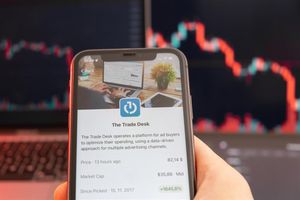
The global financial markets are witnessing a profound and irreversible shift, with retail investors emerging as a formidable force. No longer content to be mere spectators, individual investors, armed with commission-free trading platforms, readily accessible information, and the collective power of social media, are actively shaping market trends, influencing stock valuations, and demonstrating remarkable "dip-buying resilience" during downturns. This burgeoning influence is not just a passing fad; it's a structural transformation that is redefining market dynamics, challenging institutional norms, and creating both new opportunities and complex challenges across various sectors, from high-flying artificial intelligence (AI) to burgeoning green energy and the often-volatile consumer discretionary segment.
A New Era of Market Participation and Resilience
The surge in retail investor participation has become a defining characteristic of the post-pandemic financial landscape. Retail trading volume now constitutes a significant portion of daily equity activity, reaching as high as 23% in 2023 and currently representing approximately 20% of daily U.S. equity trading volume, a substantial increase from about 10% a decade prior. This phenomenon is largely driven by technological advancements that have lowered barriers to entry, making investing more accessible, especially for younger generations. Platforms like Reddit's WallStreetBets, X (formerly Twitter), and TikTok have fostered online communities that facilitate rapid information exchange and coordinated trading, often leading to a "herd mentality" that can amplify market movements.
A standout characteristic of this new wave of retail investors is their "dip-buying resilience"—a consistent strategy of purchasing stocks during market downturns. This behavior has provided an "unprecedented cushion" for the market, helping to prevent sharper declines and often propelling indices back to highs even amidst significant volatility. For many younger investors, who have primarily experienced prolonged bull markets, this strategy has proven consistently rewarding. For instance, in early April 2025, when the S&P 500 index fell by approximately 5% over two consecutive trading days, retail investors entered the market in record numbers, providing crucial liquidity. Similarly, following a U.S. credit rating downgrade in May 2025, retail investors bought U.S. stocks at their highest rate ever, purchasing a net of $4.1 billion in just the first three hours of trading. This consistent buying pressure challenges traditional views of retail investors as purely speculative traders who exacerbate volatility, instead positioning them as a stabilizing force, albeit one that can also introduce its own forms of market distortion.
Retail's Ripple Effect: Winners and Losers in a Shifting Market
The increasing influence of retail investors has created clear winners and losers across various sectors, fundamentally altering stock performance and market dynamics.
The consumer discretionary sector has been at the forefront of retail investor interest, particularly through the "meme stock" phenomenon. Companies like GameStop (NYSE: GME) and AMC Entertainment (NYSE: AMC) became symbols of this retail power. In early 2021, GameStop's stock experienced an astronomical rise, driven by coordinated retail investors rallying against institutional short-sellers, leading to a massive short squeeze. AMC also saw its stock price propelled to unprecedented heights, enabling the company to raise substantial capital through equity offerings, despite facing significant financial challenges due to the COVID-19 pandemic. However, this retail-driven enthusiasm also brought extreme volatility. GameStop saw 34 price movements greater than 5% in the year leading up to September 2025, and AMC's stock has oscillated wildly, often disconnected from its underlying business fundamentals. Retail investors who bought at peaks often faced significant losses, underscoring the speculative nature of such plays. Despite an August 2025 Q2 earnings beat, AMC's stock remained down 42% over the preceding 12 months, grappling with over $4 billion in debt, indicating that retail sentiment, while powerful, cannot entirely overcome fundamental business challenges.
The AI and Technology sector has also been a major beneficiary of retail enthusiasm, particularly in companies perceived as future innovators. Tesla (NASDAQ: TSLA) stands out, with retail investors exhibiting "undying faith" in the company, often viewing its value proposition beyond traditional sales figures, fueled by Elon Musk's promises of an AI-driven mobility future. This sustained faith has historically led to significant dip-buying; for instance, after news of a 40% plummet in Tesla's European sales in January 2025, retail investors poured $7.3 billion into the stock over 12 days, marking its largest buying streak in a decade. However, this hasn't always protected retail investors from drawdowns, with those who bought the dip in early 2025 being down 7% year-to-date, and the stock falling 17% during a March 2025 buying streak. Beyond Tesla, retail investors consistently supported "Magnificent 7" stocks (including Amazon (NASDAQ: AMZN), Apple (NASDAQ: AAPL), Microsoft (NASDAQ: MSFT), Meta (NASDAQ: META), Nvidia (NASDAQ: NVDA), and Alphabet (NASDAQ: GOOGL)). More recently, a shift has been observed, with retail investors engaging in "classic profit-taking" from Nvidia after a share jump, and instead piling into smaller, riskier "second-derivative AI laggards" and quantum computing stocks like Applied Digital (NASDAQ: APLD), Navitas Semiconductor (NASDAQ: NVTS), D-Wave Quantum (NYSE: QBTS), and Rigetti Computing (NASDAQ: RGTI), with purchases increasing by over 150% for some, signaling a hunt for higher-risk, higher-reward AI opportunities.
In the green energy sector, retail investors demonstrate a preference for sustainable investments, often influenced by real-world climate events. Trading activity in "green" firms significantly increases after extreme weather events, which heighten awareness of climate-related risks, suggesting a "dip-buying resilience" driven by environmental consciousness. Dips in renewable energy stocks, even those caused by political uncertainty, are often seen by savvy investors as strategic buying opportunities for long-term gains, recognizing the global shift towards clean energy. Companies in offshore wind and solar power are considered well-positioned. However, the sector has faced significant headwinds, including high inflation and rising interest rates, which caused the S&P Global Clean Energy Index to fall drastically from January 2021 to January 2025, impacting companies like Ørsted (CPH: ORSTED). Despite retail interest, the sector's performance remains highly susceptible to macroeconomic factors, and many retail-favorite energy stocks, particularly in emerging markets, have seen declines in 2025, indicating sector-wide challenges.
Broader Implications: Reshaping the Financial Ecosystem
The burgeoning influence and "dip-buying resilience" of retail investors are not isolated phenomena but are deeply intertwined with broader industry trends, creating ripple effects across the entire financial ecosystem. This democratized access to markets, facilitated by technology and social media, marks a fundamental shift away from an institution-dominated landscape.
This trend fits into a wider movement toward the democratization of finance, where individuals have unprecedented access to tools and information previously reserved for professionals. The sustained "buy the dip" mentality, particularly among younger investors who have primarily experienced bull markets, provides an "underappreciated cushion" during downturns, helping to stabilize markets and making short-selling more challenging for institutional investors. This new dynamic sometimes forces seasoned Wall Street professionals to rethink their strategies, as retail sentiment can drive asset prices in ways not always aligned with traditional fundamental analysis. Beyond public equities, there's a growing trend of retail investor access to private markets, previously exclusive to institutional players, which could further diversify retail portfolios and potentially narrow wealth gaps.
The ripple effects extend to all market participants. Institutional investors are increasingly finding themselves adapting to, rather than dictating, market narratives. The collective action of retail investors, as seen in the GameStop saga, can even force short-sellers to unwind positions, demonstrating the power to disrupt established strategies. Public companies are also realizing the need to engage directly with their retail shareholder base, as this group can significantly affect stock prices and corporate votes, necessitating more robust investor relations strategies tailored to digital engagement. Brokerage and financial advisory firms are also adapting, with the proliferation of commission-free trading driving competition and increasing demand for user-friendly platforms, robo-advisors, and accessible financial education.
From a regulatory standpoint, the rise of the retail investor presents both opportunities and challenges. Regulators like the U.S. Securities and Exchange Commission (SEC) and FINRA are under pressure to enhance protections for retail investors, particularly those using online platforms that offer complex and high-risk trading products. Concerns exist that sudden, coordinated bursts of retail activity, especially through social media, can distort prices, amplify volatility, and potentially lead to market manipulation. This highlights the need for robust investor education, clear disclosure requirements, and careful oversight of social media's role in financial advice. Historically, this period echoes the Dot-Com Boom of the late 1990s, where retail investors engaged in speculative trading, often reacting to non-fundamental information via online chat rooms. However, today's retail investor has access to far more sophisticated tools and a greater collective voice, making this era distinct in its potential for sustained influence and systemic impact.
What Comes Next: A Hybrid Financial Future
The increasing influence of retail investors is not merely a cyclical trend but a structural shift that will continue to shape financial markets for the foreseeable future. The short-term and long-term implications suggest a hybrid financial model, where success will depend on adaptability to both technological advancements and evolving social sentiment.
In the short term, retail "dip-buying" is likely to continue acting as a stabilizing force during market pullbacks, contributing to quicker recoveries. However, this strategy carries inherent risks, especially if market conditions shift to prolonged declines rather than rapid rebounds. We can expect continued volatility, particularly fueled by retail activity in thematic and "meme" stocks, as well as a heightened use of options trading, including zero-day-to-expiration (0DTE) contracts, which can amplify market swings. Retail investors' strong sensitivity to momentum and thematic investments, especially in areas like AI, will likely continue to drive sector-specific surges.
Looking at the long term, the financial world is heading towards a more integrated model. Retail investors are expected to become more sophisticated, moving beyond purely performance-chasing to more strategic risk management and diversification, potentially trimming exposure to highly concentrated mega-cap stocks for broader portfolio balance. Their interest in alternative assets, such as cryptocurrencies and private markets, is also projected to grow significantly. Critically, retail investors are also becoming more vocal in corporate governance, impacting proxy battles and demanding greater transparency and adherence to Environmental, Social, and and Governance (ESG) factors from companies.
To adapt, companies must re-evaluate their investor relations strategies, embracing transparent, bi-directional digital communication with their diverse retail shareholder base. They will need to clearly articulate their ESG path and be prepared for potential retail activism. For institutional investors, integrating retail-driven momentum into their strategies, employing dynamic hedging using VIX derivatives, and leveraging AI to identify mispricings caused by retail sentiment will be crucial. Brokerages and wealth managers must transform their business models, focusing on user-friendly interfaces, enhanced technology, and robust financial education to empower retail investors. Regulators will continue to face the challenge of balancing market access with investor protection, scrutinizing trading platforms, oversight, and potential market manipulation, while also considering how to address the risks of misinformation in a socially connected financial world.
Emerging market opportunities include increased access to capital for businesses, improved market liquidity, and growth in thematic investing and new asset classes. However, challenges loom, such as increased market volatility, potential price distortions driven by sentiment, and the risk that the "dip-buying" strategy could fail in a sustained bear market.
Conclusion: The Enduring Impact of a Resilient Force
The rise of the retail investor, underpinned by their remarkable "dip-buying resilience," represents a fundamental and enduring shift in the financial landscape. It signifies nothing less than the democratization of finance, empowering individuals to participate in capital markets and build wealth in ways previously unimaginable. This transformation necessitates a focus on building responsible capital market ecosystems, characterized by robust investor protection, accessible financial education, and ethical advisory models.
The key takeaway is that retail investors are now a permanent, powerful fixture in the markets. Their collective buying power, often amplified by online communities, acts as a significant counterweight to institutional selling during downturns, contributing to shallower and shorter market corrections. However, this power also introduces increased volatility and the potential for speculative bubbles in certain segments, testing the traditional mechanisms of price discovery and market efficiency.
Moving forward, the market will be defined by a complex interplay between retail sentiment and institutional strategies. Investors should closely monitor geopolitical and macroeconomic developments, as these will continue to drive overall market sentiment and volatility. The regulatory landscape will also be critical, with potential new rules impacting investor access and protections. Furthermore, the continuous advancement of AI-driven tools in investing will reshape decision-making processes, offering both opportunities and risks. Individual investors must remain vigilant, avoid "herding" behavior, prioritize diversification and sound risk management, and critically assess broader retail sentiment, especially in highly speculative areas. Finally, keep an eye on the performance of major tech stocks, the "Magnificent 7," as their substantial weighting means their trajectory will continue to significantly impact overall market indices. The future of finance is here, and it is undeniably more inclusive, dynamic, and at times, more unpredictable, thanks to the resilient power of the retail investor.
\






